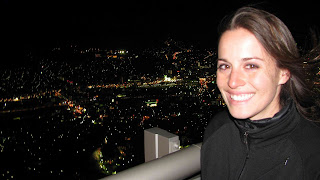Beautiful, picturesque Nagasaki is nestled among mountains along the western Japanese coast. A nighttime trip on the cable car gave us a panoramic view of the city as it stretched across the valley.
The next day we would watch video simulations showing where the epicenter of the atomic bomb tore through that same valley. Nagasaki’s Peace Park was built at this site and cherry blossoms were in full bloom, belying any sign of what once happened there. The nearby museum graphically accounts the bomb’s toll (75,000 people killed in 3 seconds, out of a population of 240,000) and has audio testimonies of people who lived through the blast and described their ordeal on a very personal level. The word “sad” can’t even begin to describe it. I couldn’t shake the feeling of self-consciousness at being an American here and, yet, the Japanese have only espoused a resounding message of peace. It made the whole experience that much sadder.














































